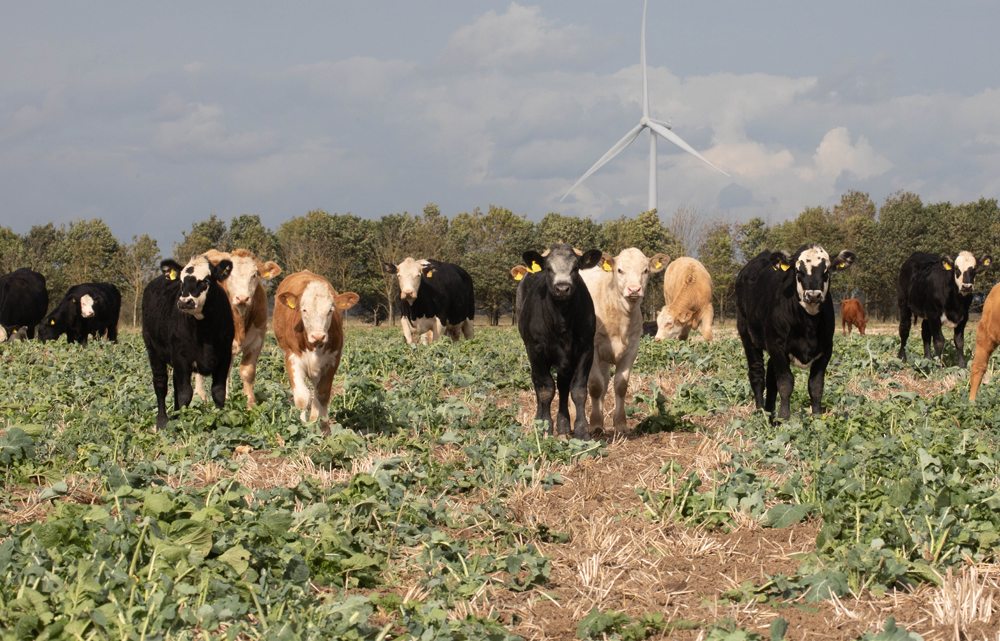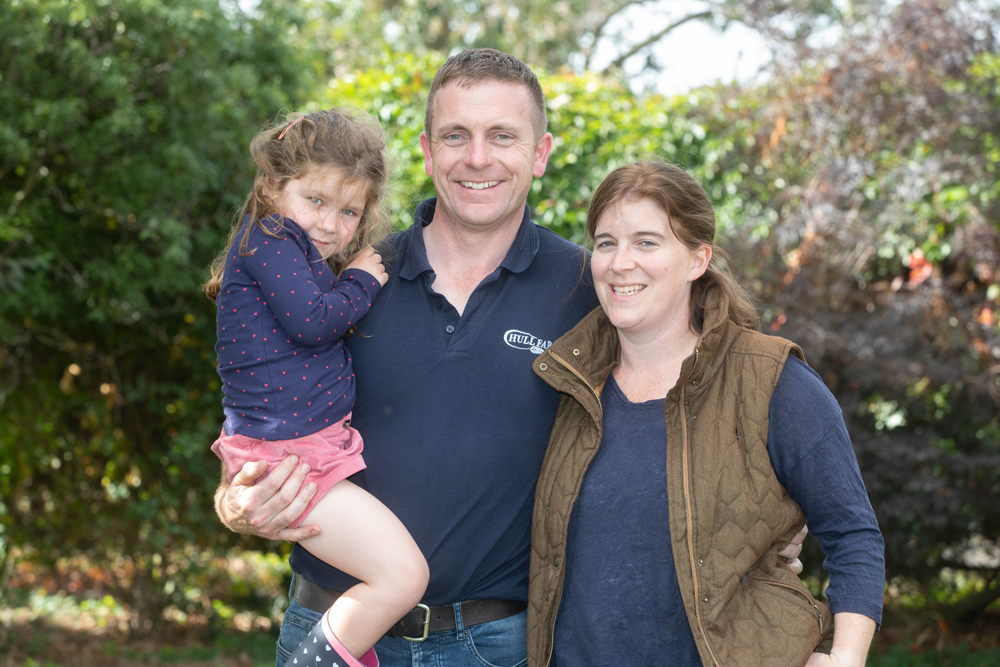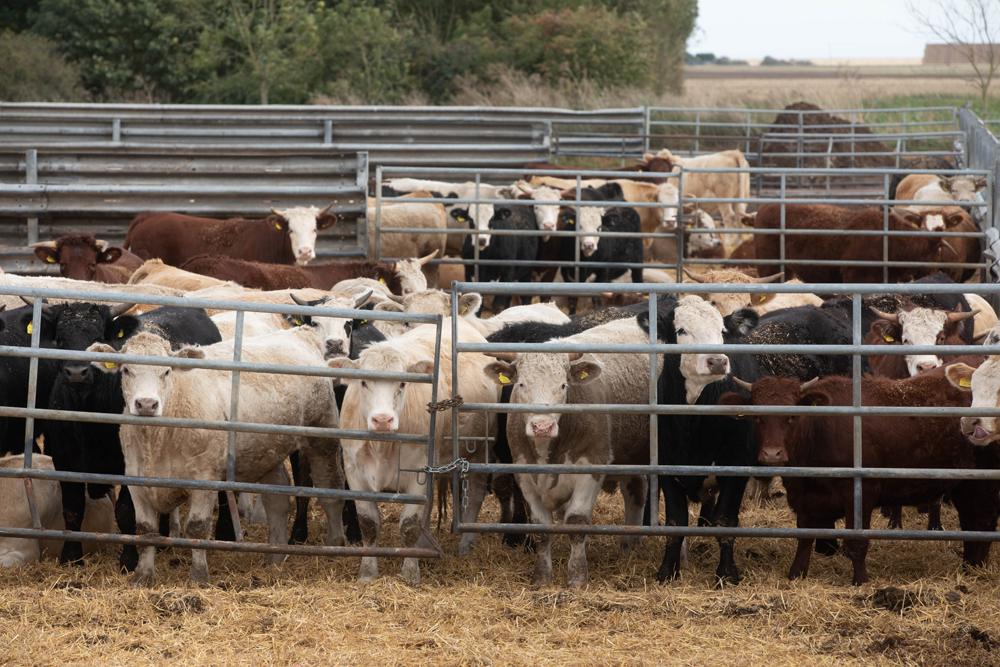
For the Hull family at Turncole Farm, Southminster, Essex, the Hereford breed has for a long time built the basis of their large scale cattle enterprise.
Always keen for a challenge, David, Edward and Ann Hull operate under the Hull Farms name, running 800 suckler cows in what is otherwise the bread basket of Great Britain, being surrounded by arable production.

Dairy-Hereford cross calves from around the country are purchased in the autumn to rear as female replacements. The family choose this cow for its placid temperament and quality of beef, and currently 700 of the 800 cows on-farm are of this cross. With a lack of stock in the immediate area, the family travels for hundreds of miles to source these young heifers, often making on-farm purchases in East Anglia or visiting markets in the milk fields of the north west.
It is the breed’s docility, motherability and uniformity which makes the Hereford such a good female, explains Edward, and when it is coupled with added milkyness from its dairy mother, a breeding female is produced which suits their system.
Calves are purchased in a window of four months from the end of summer so they all grow as one management group and can be served at a similar time. Arriving at the farm at two to six weeks old, they are then bucket reared at David’s base in Halesworth, Suffolk, where 60 per cent of the farm’s grass-keep can be found. The farm at Halesworth acts as a quarantine unit and on arrival, calves are vaccinated for pneumonia and IBR.
Calves are reared outside in shelters made out of straw bales, which provide good air movement, says Edward, while also keeping calves warm.
The calves stay in Suffolk until they are 12 to 14 months old. This growing period is spent on sandy soils and calves are out-wintered on a forage-based ration of grass silage, hay and barley straw. Supplementary meal is given as required, which is purchased in as whole barley and milled on-farm, while home-produced wheat goes for bread milling.
They then move to Essex into the outside yards for their second winter. At this point, pelvic measurements are taken as the family constantly strives to improve management and performance.

Edward and Ann Hull
Edwards explains: “We have started to combat any potential calving problems by carrying out pelvic measurements, which just puts us ahead of the game. Those sitting in the bottom 10 per cent will be culled from the herd and further 10 per cent of the herd will be taken out due to growth, which we assess by eye.”
To encourage calving ease, the Hulls opt for big cows with plenty of room inside them, weighing around 700 to 800kg. Every heifer is also freeze branded with a letter which corresponds to when it was born.
Edward says: “Both sides of an animal’s parentage need to be substantial to be able to breed a decent animal. The cull cow value is very important to our business. With the fluctuations in the beef market, we must have a good carcase at the end of the female’s productive life.
“If we have done our job right, we won’t have any problems at calving; if we get body condition score, feeding and bull choice right, it should be straight forward.”

Edward estimates just 2 per cent of his Hereford-cross cows need assistance at calving. They try to keep nightime disturbance down to a minimum with the calving cows. Cows are checked for the last time as night falls and are only re-visited if a cow is still in labour, keeping a special eye out on heifers.
The Hulls calve 200 heifers in the spring and 50 in the autumn. On these young females, they opt to use a Saler bull; a breed which when crossed with the Hereford, leads to minimal calving problems, while also producing a saleable product at the end of it, explains Edward. On first calved heifers and cows, they opt to use Charolais or Angus bulls. The bulls go in with all the spring calving heifers and cows on the 25 May where they remain for nine weeks.
There are a number of other breeds in the suckler herd but these are being phased out.
“We prefer the Hereford crosses as they have longevity and they knit well with the Charolais bulls,” comments Edward.
Focus is put on EBVs when buying in bulls and they opt to purchase sires with a growth rate in the top 10 per cent, chasing performance to finish cattle between 14 and 18 months old. To make this achievable, all the offspring have creep and are weaned in the months of September and October.
Edward says weaning is fairly quick and takes three to four days with little aggro or reduction in growth. Calves are weaned off their mothers in groups of 40 before going in to outdoor corral yards.
Cattle are fed a mixed TMR ration throughout winter and they aim to hit 300 to 340kg deadweight at 14 months.

Each year, 1,000 bales of high quality silage bales are made for the young Hereford-cross calves. In addition 800 tonnes of hay, 2,500 tons of forage rye and 1,500 tons of fodder beet are made each year. The family also bales 5,000 tons of straw each year and buying 3,000ac (1,214ha) as standing from local farms with surplus straw exported to Europe.
It makes the mind wonder why in an area known predominantly for its arable production, does the family continue to keep livestock? But the Hulls say it is in their blood, having previously also been in dairying, keeping 300 cows in the late 90s; a notable number both then and now.
Once the dairy herd was dispersed, they moved to buying in and fattening 1,500 head of cattle, but the outbreak of foot and mouth in 2001 made this unviable, claims Edward whose wife Ann is also from a family farm in Northamptonshire.
Edward says: “Historically we have sold our offspring as suckled calves, hauliing them up to Rugby Market, but with the beef price in the doldrums, the operation now, more than ever, has to run as efficiently as possible.
“To maximise the returns on cattle sales, we are keeping cattle longer so we can watch the market and choose when the best time to sell them is. The ease of management the Hereford has brought to our system has saved timed and in turn has added profitability. With young children, footpaths and staff on the farm, we do not need to keep dangerous cattle.”
The lack of local stock also means there is reduced competition when it comes to taking on grazing, and ground can be secured for sensible money for ‘conservation grazing’.
The dry climate of just 450mm (18 inches) annual rainfall and the sandy soil, being just in land from the east coast sea wall, means the window of time cattle can be kept outside is lengthened at both ends, reducing the expense of costly winter housing.
Cattle are killed and cut at Fowler Brothers at Burnham-on-Crouch, Essex. This local company has strong links into the city of London where it is marketed as native and targeted at the wealthy, discerning customer. Each week the family sends 12 to 15 cattle there, along with 100 lambs.
This butchery is looking for consistency and eating quality and the Hulls’ system fits the bill, they say.
Edward says; “A lot of the eating quality is due to the quarter-bred Hereford animal we are producing, and also the high starch ration which the finishing cattle receive.”
While the cows and calves are out grazing all the calves have access to a home-blended creep feed, to maximise the growth of the calve while suckling.
“They also wean better if they are on creep feeders before they leave the cow. They don’t go backwards but they instead get straight onto the creep and keep growing,” says Edward.
Forage rye is the latest addition to the farm’s rotation and 120ac (49ha) have been adopted in place of maize this year. The forage rye has been chosen over maize as Edward describes maize is a very expensive crop to grow, not always being cost efficient.
“Forage rye is a hybrid crop, with capabilities off a large tonnage per acre. It can be so dry here that the conditions don’t always allow maize to start off properly and can also create soil compaction at harvest time.
“Furthermore, we would also like to assess our winter feed stocks earlier in the year and with the forage rye cut in June, we have considerably more time to plan our winter feeding. The rye has similar protein and starch levels while being cheaper and more reliable. We follow this crop with stubble turnips for cows and calves to graze or lambs to finish on.”
Ground is rented for fodder beet, which sees 1,500 tonnes grown for winter feed stocks.
“All cattle are fed a TMR forage and straw based diet with only citrus pulp, brewers’ grains and potato by-products purchased in the winter to service the 2,500 head of cattle. This equates to an average feed intake of 18.5kg per head across all mouths for a 150 day winter,” Edward says.
With the introduction of compulsory electronic tagging Edward and Ann are eager to adopt this technology, due in autumn 2021. Rather than a legislative burden, they view electronic identification as a management tool with efficiency potentials and say it will be useful to them in recording and monitoring daily live weight gains.
Looking forward, Edward says he would like to maintain cow numbers and embrace the changes that Brexit may throw at us in the near future. The family also wishes to improve the infrastructure of the farm to make their working lives more efficient.
“Whether we expand any further all depends on availability of winter housing, profitability and staffing. Ideally we would like to keep cows in cubicles but they are just too expensive to fit our system at the moment,” explains Edward.
Farm facts:
- 800 suckler cows, 700 of which are Hereford cross Holsteins/Friesian
- 2,428 hectares (6,000 acres)
- 405ha (1,000ac) of arable
- 2,023ha (5,000ac) grass all within 85 miles
- Grass is rented from five different landlords
- 2,000 breeding ewes (Romney, NCM, Dorset and Easycare)
- 1,214ha (3,000ac) standing straw purchased each year
- Half of their bales are exported to Holland
- 7 wind turbines
- In the winter, 182ha (450ac) of various cover crops and stubble turnips on other people’s ground.